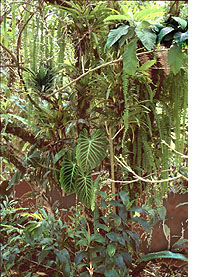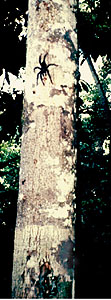The Rainforest Canopy
By Chuck Hubbuch, former Director of Plant Collections

What do you think about when you think of a rainforest? Do you imagine the set of a Tarzan movie, with swinging vines, exotic animals everywhere and dense vegetation on the forest floor? Maybe you picture yourself in a green jungle of twisting vines and slender branches, hacking your way slowly through the dense vegetation with a machete, sweaty and exhausted by the intense tropical sun, and nervously watching for dangerous snakes and wild cats.
Now, let us imagine that you are standing in a real rainforest. Look around at the tall, dark tree trunks, like massive columns, widely spaced, holding up the high ceiling. Here and there, a vine the size of your waist loops and twists into the tallest branches. You can see that the rainforest is shady, the ground nearly devoid of foliage and the temperature is warm but comfortable. It is a quiet place with an open understory and soft, decaying leaves on the floor. The most dangerous animals are not jaguars and snakes, but small, biting insects and the microscopic parasites they carry. By this time, you should be reaching for the bug repellent.

So, where is this tremendous diversity of life that is supposed to be in the rainforest? Much of the diversity is made up of small things like insects. If you are here for very long, you will see lots of "bugs." Some of them, such as mosquitos, will come looking for you. A lot of animals are nocturnal. Walking around at night with flashlights, you can see frogs, snakes, bats, spiders and many other things that you rarely see during the day. Okay, I guess I will be taking this walk alone tonight. More importantly, however, you should know that most of the life in the rainforest is in the canopy, high above your head. Be glad you wore your hat.
Most of the forest's activities are happening high above in the sunlight. The tall tree trunks support leafy canopies that are competing for space at the top. Vines push themselves through the openings and spread out on the tree canopy, fighting for their place in the sun. Epiphytes, including orchids, bromeliads and many others, have lived for countless generations on tree branches without ever putting a root into the ground. Photosynthesis, flowering, fruiting, competiton with other plants and chemical warfare with leaf-eating insects and harmful fungi is going on way up there in the sunlight. With the so many heavy branches, interlocking vines and thick layers of epiphytes, many animals live out their lives like the epiphytes, never setting foot on the ground.
Flying animals, like birds, bats and insects, are perfect candidates for life in the trees. You would expect animals that climb for a living, animals like lizards, monkeys and squirrels, to spend much of their lives in the forest canopy. But did you know that some frogs live and reproduce in the trees? They start life as tadpoles in the water-holding bromeliads high in the tree tops. Earthworms and other soil-dwelling creatures burrow through the accumulated debris and organic material on high branches among the epiphytes. Some mosquito larvae specialize in an existence in the water of tree holes. It really is another world.
So now that you know where the action is, how do you find out what is happening a hundred feet or more off the ground? You can lean back with a powerful pair of binoculars or a telescope. You can climb up steep, wet hillsides and look over at the tree tops. A slender tree can be climbed like a rope, hand over hand, but you cannot get very far before it bends over or breaks. From time to time, large trees crash to the ground making their epiphytes available for study, but the more mobile animals leave quickly. Entomologists have released insecticide bombs that kill the insects in a tree and collected those that fell to the ground. In the past, when the tropical forest seemed limitless, researchers cut down trees or climbed with telephone pole spikes.
Most modern scientists climb using methods that minimize harm to the environment. A research site in Panama used a tall crane to lift a cage of researchers high into the branches. Combining inovation with mountain climbing techniques, they slingshot string over tall branches, pull up successively stronger ropes and then use ascenders to climb into the canopy. With a network of ropes and pulleys, scientists can move the about high branches with a great deal of freedom. A few research facilities and ecotourist destinations have constructed elevated walkways. One project employs a hot air ballon to survey the canopy from above and drops a large inflatable raft onto the top of the canopy. Scientists scramble about the raft collecting specimens from the highest points in the forest.
Standing here on the floor of our imaginary rainforest, the mere idea of climbing to the tops of these tall trees is enough to make us grateful for the solid ground under our feet. Nevertheless, the richest part of the most diverse ecosystem on the planet is so poorly known that one author refered to it as the high frontier. This ignorance of the canopy is what drives scientists to explore and take the risks. For us, it is one more reason to do all we can to conserve the remaining rainforests.
Copyright © 2005 Fairchild Tropical Botanic Garden, 10901 Old Cutler Road,
Coral Gables, FL 33156 USA Phone: (305) 667-1651 Fax: (305) 661-8953